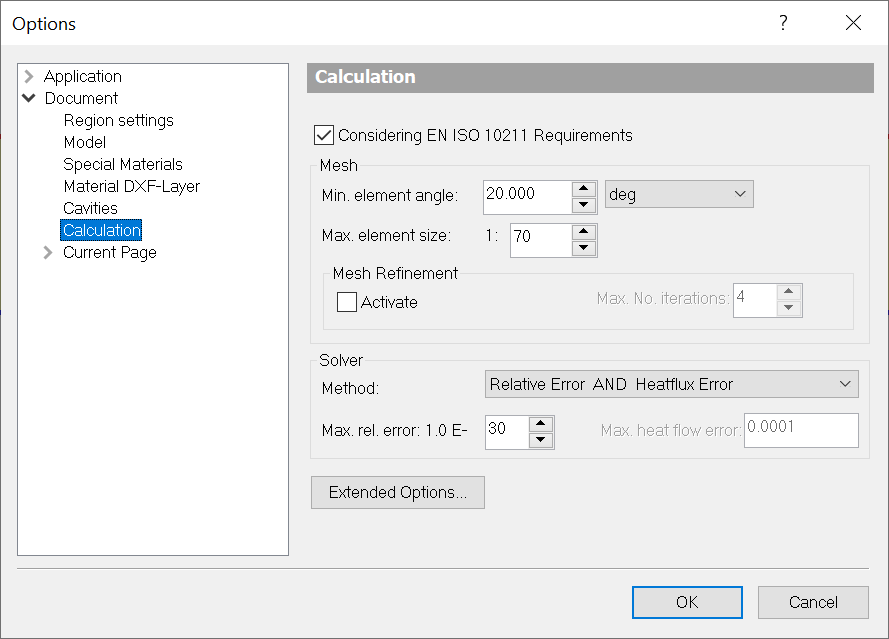Description
In the calculation dialog window, the parameters for the calculation process can be determined. The correct parameter settings are important to obtain accurate (and sensible) results.
The calculation process is comprised of four parts:
•Generation of the element grid
•Calculation of temperature dependent conductivity values
•System equation solutions
•Automatic Mesh Refinement

Fields
Considering EN ISO 10211 Requirements |
If this option is selected, the conditions of calculation will automatically meet the standard EN ISO 10211 : - The maximum heat flow error is less than 0.0001. The heat flow errors is the ratio of the sum of all signed heat flows and half of the sum of absolute values of the heat flows. - The model is calculated twice, once with the number of elements characterized in Max. element size, once with the double number of elements. The sum of the absolute values of all heat flows will be determined for both meshes. If the relative difference of the two sums is greater than 1%, the grid will automatically refined. |
Min. element angle |
Minimum angle, which the individual mesh elements (finite elements) area is allowed to have. This value should not be too small (physical reasons) and should not be too big (because otherwise mesh generation is not possible). |
Max. element size |
Maximum permitted size for a mesh element (finite element). This number is a ratio that is relevant to the size (maximum measurement of the circumscribing rectangle). |
Mesh Refinement |
If this option is selected, the element mesh is refined automatically in those areas, where the relative error of the current solution is greater than a critical limit. The mesh refinement will continue as long as the relative error at any point is larger than this critical value or the maximum number of runs is reached. |
Method |
The termination criteria for the solver. The Relative Error refers to the calculated temperatures and the Heat Flow Error refers to the heat flow. Either, only a single criterion or a combination of both criteria can be used. |
Max. rel. error: |
Determines the maximum relative error of the solution vector. If this method is selected, the resulting system equation will be solved iteratively until the relative error is less than this value, or until the maximum number of iterations has been reached. |
Max. heat flow error |
Determines the maximum heat flow error according to standard EN ISO 10077-2 (see above). If this method is selected, the resulting system equation will be solved iteratively until the relative heat flow error is less than this value, or until the maximum number of iterations has been reached. |
Max. rel. changes |
The calculation of temperature dependent conductivity values will continue until either the relative change of the conductivity value of all domains with temperature dependent conductivities are smaller than the maximal tolerated relative change, or the maximum number of iterations has been reached. |
Max. No. iterations |
Determines the maximum number of iterations (for the calculation of temperature dependent conductivities as well as the automatic mesh refinement). |
Extended Options... |
Opens an additional dialog window, where you can adjust further calculation settings. |